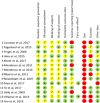Brain Modulation by Electric Currents in Fibromyalgia: A Structured Review on Non-invasive Approach With Transcranial Electrical Stimulation
- PMID: 30804771
- PMCID: PMC6378756
- DOI: 10.3389/fnhum.2019.00040
Brain Modulation by Electric Currents in Fibromyalgia: A Structured Review on Non-invasive Approach With Transcranial Electrical Stimulation
Abstract
Fibromyalgia syndrome (FMS) is a complex disorder where widespread musculoskeletal pain is associated with many heterogenous symptoms ranging from affective disturbances to cognitive dysfunction and central fatigue. FMS is currently underdiagnosed and often very poorly responsive to pharmacological treatment. Pathophysiology of the disease remains still obscure even if in the last years fine structural and functional cerebral abnormalities have been identified, principally by neurophysiological and imaging studies delineating disfunctions in pain perception, processing and control systems. On such basis, recently, neurostimulation of brain areas involved in mechanism of pain processing and control (primary motor cortex: M1 and dorsolateral prefrontal cortex: DLPFC) has been explored by means of different approaches and particularly through non-invasive brain stimulation techniques (transcranial magnetic and electric stimulation: TMS and tES). Here we summarize studies on tES application in FMS. The great majority of reports, based on direct currents (transcranial direct currents stimulation: tDCS) and targeting M1, showed efficacy on pain measures and less on cognitive and affective symptoms, even if several aspects as maintenance of therapeutical effects and optimal stimulation parameters remain to be established. Differently, stimulation of DLPFC, explored in a few studies, was ineffective on pain and showed limited effects on cognitive and affective symptoms. Very recently new tES techniques as high-density tDCS (HD-tDCS), transcranial random noise stimulation (tRNS) and tDCS devices for home-based treatment have been explored in FMS with interesting even if very preliminary results opening interesting perspectives for more effective, well tolerated, cheap and easy therapeutic approaches.
Keywords: fibromyalgia (FM); non-invasive brain stimulation (NIBS); tDCS — transcranial direct current stimulation; tRNS (transcranial random noise stimulation); transcranial electrical stimulation (tES).
Figures



Similar articles
-
Motor cortex tRNS improves pain, affective and cognitive impairment in patients with fibromyalgia: preliminary results of a randomised sham-controlled trial.Clin Exp Rheumatol. 2017 May-Jun;35 Suppl 105(3):100-105. Epub 2017 Jun 29. Clin Exp Rheumatol. 2017. PMID: 28681715 Clinical Trial.
-
Transcranial Direct Current Stimulation Targeting Primary Motor Versus Dorsolateral Prefrontal Cortices: Proof-of-Concept Study Investigating Functional Connectivity of Thalamocortical Networks Specific to Sensory-Affective Information Processing.Brain Connect. 2017 Apr;7(3):182-196. doi: 10.1089/brain.2016.0440. Brain Connect. 2017. PMID: 28142257 Free PMC article. Clinical Trial.
-
Non-invasive brain stimulation and neuroenhancement.Clin Neurophysiol Pract. 2022 May 25;7:146-165. doi: 10.1016/j.cnp.2022.05.002. eCollection 2022. Clin Neurophysiol Pract. 2022. PMID: 35734582 Free PMC article. Review.
-
The added value of auditory cortex transcranial random noise stimulation (tRNS) after bifrontal transcranial direct current stimulation (tDCS) for tinnitus.J Neural Transm (Vienna). 2017 Jan;124(1):79-88. doi: 10.1007/s00702-016-1634-2. Epub 2016 Oct 19. J Neural Transm (Vienna). 2017. PMID: 27761741 Clinical Trial.
-
Non pharmacological treatment for neuropathic pain: Invasive and non-invasive cortical stimulation.Rev Neurol (Paris). 2019 Jan-Feb;175(1-2):51-58. doi: 10.1016/j.neurol.2018.09.014. Epub 2018 Oct 12. Rev Neurol (Paris). 2019. PMID: 30322590 Review.
Cited by
-
Methods and strategies of tDCS for the treatment of pain: current status and future directions.Expert Rev Med Devices. 2020 Sep;17(9):879-898. doi: 10.1080/17434440.2020.1816168. Epub 2020 Sep 15. Expert Rev Med Devices. 2020. PMID: 32845195 Free PMC article. Review.
-
Active and sham transcranial direct current stimulation (tDCS) improved quality of life in female patients with fibromyalgia.Qual Life Res. 2022 Aug;31(8):2519-2534. doi: 10.1007/s11136-022-03106-1. Epub 2022 Mar 1. Qual Life Res. 2022. PMID: 35229253 Free PMC article. Clinical Trial.
-
A Randomized, Double-Blind, Sham-Controlled Trial of Transcranial Direct Current Stimulation for the Treatment of Persistent Postural-Perceptual Dizziness (PPPD).Front Neurol. 2022 Apr 14;13:868976. doi: 10.3389/fneur.2022.868976. eCollection 2022. Front Neurol. 2022. PMID: 35493817 Free PMC article.
-
Offset analgesia is associated with opposing modulation of medial versus dorsolateral prefrontal cortex activations: A functional near-infrared spectroscopy study.Mol Pain. 2022 Jan-Dec;18:17448069221074991. doi: 10.1177/17448069221074991. Mol Pain. 2022. PMID: 35083928 Free PMC article.
-
Movement observation activates motor cortex in fibromyalgia patients: a fNIRS study.Sci Rep. 2022 Mar 18;12(1):4707. doi: 10.1038/s41598-022-08578-2. Sci Rep. 2022. PMID: 35304530 Free PMC article.
References
-
- Bazzichi L., Giacomelli C., Consensi A., Atzeni F., Batticciotto A., Di Franco M., et al. (2016). One year in review 2016: fibromyalgia. Clin. Exp. Rheumatol. 34(2 Suppl. 96), S145–S149. - PubMed
Publication types
LinkOut - more resources
Full Text Sources
Miscellaneous

